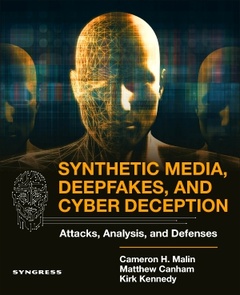Synthetic Media, Deepfakes, and Cyber Deception Attacks, Analysis, and Defenses
Auteurs : Malin Cameron H., Canham Matthew, Kennedy Kirk

Synthetic Media, Deepfakes, and Cyber Deception: Attacks, Analysis, and Defenses introduces the only analytical Synthetic Media Analysis Framework (SMAF) to help describe cyber threats and help security professionals anticipate and analyze attacks. This framework encompasses seven dimensions: Credibility, Control, Medium, Interactivity, Familiarity, Intended Target, and Evocation. Synthetic media is a broad term that encompasses the artificial manipulation, modification, and production of information, covering a spectrum from audio-video deepfakes to text-based chatbots. Synthetic media provides cyber attackers and scammers with a game-changing advantage over traditional ROSE attacks because they have the potential to convincingly impersonate close associates through text, imagery, voice, and video. This burgeoning threat has yet to be meaningfully addressed through any written treatment on the topic. The book is co-authored by three cyber influence and deception experts who have gained deep knowledge and experience on the topic through diverse, true operational pathways and backgrounds. The diversity and perspectives of the author team makes the content in the book the broadest and deepest treatment of synthetic media attacks available to readers.
Section I: Principles of Influence and Persuasion 1. Psychological Principles of Online Influence 2. Online Credibility Assessment 3. The Psychology of Trust Section II: Principles of Online Deception 4. The Psychology of Deception 5. "Oh what a tangled Web 2.0 we weave": Typologies of Online Deception 6. Nation-State Cyber Deception Practices 7. Synthetic Media Use by Cyber Crime Threat Actors Section III: Understanding the Synthetic Media Assessment Framework 8. The Synthetic Media Kill Chain 9. Overview of the Synthetic Media Assessment Framework 10. Control 11. Medium 12. Interactivity 13. Familiarity 14. Intended Target 15. Evocation Section IV: Applying the Synthetic Media Assessment Framework 16. Putting it All Together—Assessing Attack Scenarios 17. SMAF Best Practices
Dr. Matthew Canham is the CEO of Beyond Layer 7, a security consulting f
- Introduces the authors’ Synthetic Media Assessment Framework (SMAF) to effectively and efficiently analyze threats based on discrete criteria
- Covers case examples to contextualize threats and assess them through the SMAF
- Provides end-of-chapter questions to re-affirm knowledge of the audience
- Includes a SMAF Analysis worksheet for tactical use in assessing threats
Date de parution : 12-2024
Ouvrage de 250 p.
Thèmes de Synthetic Media, Deepfakes, and Cyber Deception :
Mots-clés :
<; P>; Deepfakes; Artificial Intelligence; AI; Deception; Cyber Deception; Disinformation; Misinformation; Malinformation; Cyber Crime; Information Operations; Cyber Influence; Perception Warfare; Cyber Warfare; Active Measures; Reflexive Control; Cyber Misdirection; Digital Deception; Weaponized Artificial Intelligence; Generative Adversarial Networks; Narrative shaping<; /P>



